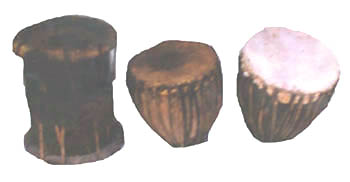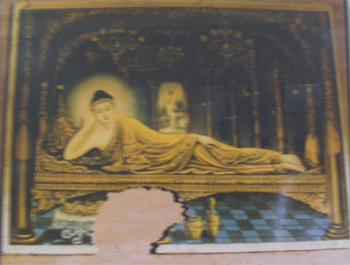|
|

Before Treatment
|
Conservation of Percussion Instruments
The Government Museum, Chennai has a Musical Instrument
Gallery as part of the anthropological galleries in the Museum. Most of them are percussion
instruments having leather as part of the instruments. These objects are affected mainly during
the winter season. Precautionary measures are taken to avoid any damage to these musical
instruments in the gallery and storage. Some outbreak of biological activity is observed some
times due to seapage, leakage or high humidity in the galleries and storage. The fungal affected
leather instruments are fumigated with thymol and dusted with a soft brush and cleaned with a
cotton swab containing rectified spirit. If the leather is hardened, then the leather portion is
softened with the help of leather dressing mixture or 2% castor oil in rectified spirit
and the extra oil on the surface is removed with a cotton swab with rectified spirit. |

After Treatment |

Before Treatment |
Restoration of Paper Prints
Paper is the support in the case of paintings on paper or paper prints.
In case of paintings on paper, a white primer is applied to take up the painting. In case of paper
prints, the printing is made on the fine surface of good quality paper. The stain, if any is
found, it may be cleaned with the help of suitable chemicals. If foxing marks or fungal stains are
found, they may be cleaned with fumigation with hydrogen peroxide in moist condition. When there
is any tear, the portion may be mended with similar paper and fixed in position cutting the new
addition according to the size of the tear using reversible adhesive like maida paste or
wheat paste. After dried, the mended portion may be retouched with watercolour pigments to match
the surroundings. In the case of the photograph, the mending is done and the area is retouched to
match the surrounding and at the same time the retouched portion is also visible.
|

After Treatment |

Before Treatment |
Conservation of Bronze Icons
Bronze is an alloy of copper and tin. It is called as 'panchaloha'
as it is believed to be an alloy of five metals-copper, tin, gold, silver and lead. But mostly
gold and silver are absent. If the environment is bad, different corrosion products are formed.
The corrosion products affect bronzes. A uniform green natural coating of basic copper carbonate
is aesthetic to look at and protective in nature and is called 'patina'. When the
corrosion product is copper chloride, it is unsightly and powdery and is called 'bronze
disease'. The bronze disease spreads from one place to the other.
The chloride is removed physically and stabilised by a 2% solution of
benzo-tri-azole in rectified spirit. The corrosion is arrested. A coating of 2% poly vinyl acetate
in acetone is given as a protective coating.
|

After Treatment |

Before Treatment |
Conservation of Thanjavur Paintings
Thanjavur Paintings (Palagai Padam)
belongs to the Thanjavur School of Art. These paintings were used for worship in houses,
temples and bhajan mantaps. Joined jack wood or teak wood planks form the support. Cloth
was the accessory support. Tamarind seed gum was used as paste. A ground, lime with glue,
was coated on the cloth and burnished to get a smooth surface. All standard sketches were
executed. Areas where the gems were to be set, gesso work carried out etc., were marked. The
relief of gesso work was done with sukkan (a paste of unboiled lime stone ground fine and
mixed with gum Arabic). Gold foil was pasted and painted with natural colours and a lac coat was
given.
As the main support of wooden planks was joined, they give way due to age
and cracking. Flaking is noticed in the paint, cardboard or / and cloth layers. The edges of the
cloth covering the plank become frayed in course of time and get loosened from the plank. Insect /
fungal attack results in loss of gemstones, pigments etc. Fading of pigments, stains and soot
deposits are common. Lac used gets darkened.
A G-clamp is used to join separated planks, cracks are filled with sukkan
putty and leveled. Injecting gum Arabic can rectify loss of adhesion between the layers. In some
cases where fungal attack to the support is immense, it is advisable to transplant the painting
onto a new wooden support. Missing gemstones, gold raking are replaced with new ones. Infilling
with sukkan and retouching with suitable paint is done wherever necessary. Dirt, dust,
soot etc., are removed from gold leaf covered and painted areas using rectified spirit or acetone.
Paintings may be fumigated for the removal of fungi and insects before framing. Any gap between
the frame and painting needs to be corrected. A coating of insecticide or sandal wood
powder is given at the back to prevent insect / fungal attack. |

After Treatment |
|
|
|
|